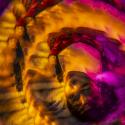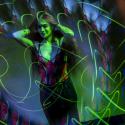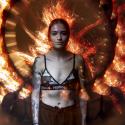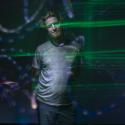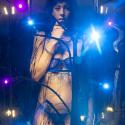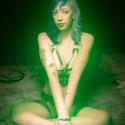Laser Positioning for your Camera Hot Shoe
One of the aspects of light painting photography is covering your lens (often called the “lens cap trick”) and moving the camera to a second location, often with a second tripod, and doing another exposure. Additionally, some people completely replace lenses mid shot and either stay more or less in the same spot or move to a second location. In both of these cases the photographer is usually trying to combine two (or more) visual elements into a single exposure. Getting the alignment between these shots is tricky because on SLR cameras you can’t see through the viewfinder once the picture has started. Enter the laser….
By attaching an inexpensive laser pointer to your camera you will be able to align (or confirm alignment) of your shot at your second location before continuing your exposure. Most modern cameras come equipped with a hot shoe; this tutorial will talk you through building a laser attachment that leverages this hot shoe. Total expense will be about ten dollars.
Materials
The materials required are minimal:
- metal mending brace ($2, hardware store)
- laser pointer ($3-5)
- hot shoe to threaded 1/4 inch adapter ($4)
- glue
- sharpie (optional)
I just bought four packaged laser pointers at the dollar store. When I got home none of them worked. I advise that you pick a laser pointer that will be a bit more reliable than that. Also, you don’t want the act of pushing down the laser pointer button to change the alignment of your shot so pick a laser pointer with a button that doesn’t offer a lot of resistance.
Prepare the Brace
My next step was to attach the brace to the adapter and draw around the edge with a sharpie. This step is optional but it will give you a visual reference for where you can successfully attach the pointer and have it not interfere with the adapter. Once you’ve drawn the line remove the brace from the adapter.
This next picture shows approximately how the two pieces are going to line up.
Apply the Glue and Attach the Laser Pointer
Attach the laser pointer to the brace with adhesive. I used Krazy Glue. The guy at the hardware store suggested Gorilla Glue but the kind they had there didn’t have a precise application tip so I opted for one that did. Put the glue on the brace, stick the laser pointer on it, line it up as close to straight as you can, then hold it and place for the recommended time. For Krazy Glue they suggest 30 seconds.
This is what you’ll be working towards. Don’t worry if it doesn’t line up perfectly.
Put it on Your Camera
The next thing you want to do is let this dry. DO NOT immediately attach this to your camera; let the glue completely dry! There is no point rushing this and risking dropping glue on your technology. (Who am I kidding? I put this right on mine but was really careful. Seriously though, don’t do this!)
Attach the hot shoe adapter to the hot shoe and tighten it down.
Next, attach the new laser pointer contraption and tighten the top down to hold it in place. Make this firm, if the laser pointer can swing side to side then you are defeating the purpose of using it for alignment.
Using your new Laser Camera
And…… you’re done! You can start using this to align your shots!
NOTE: lasers are bad for your eyes. Don't shine them in your eyes. Or your models eyes. Focus on an ear or something and have your model close their eyes while you're testing.
A few miscellaneous things to keep in mind.
- In my example the brace has staggered holes in it. That is to say that they are not centered. This means that unless you offset your laser to be in line with the holes then your reference dot will not be perfectly centered either. In my example I centered the laser on the brace which means it will be slightly offset from lens-center.
- Your SLR is shooting out of the center of your lens. The laser pointer is shooting from several inches higher. In theory they are shooting parallel to each other. In my testing this resulted in my reference laser point being slightly offset from the center of my frame. This isn’t a huge deal because when you set your shot up you can frame your shot normally and then press the laser button to see where it has to be to accomplish that framing again. This also means that when you attach the pointer to the camera that you don’t have to be perfectly aligned. What you need to be is consistent between framing and repositioning your shot.
- If you have two shots and one of them is a close up of a person and the other one is a long distance shot of a landscape or cityscape you will have much more success shooting the landscape shot first and using the laser to later reframe upon your closer subject. You’ll have a harder time finding the laser spot on a bigger and deeper area.







